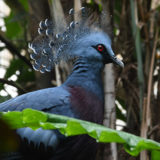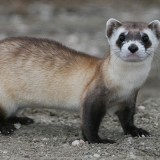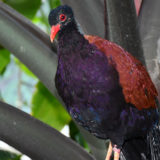RANGE
Southwestern South America from Peru south through Uruguay to Tiera Del Fuego. Found in greater numbers in Bolivia and Argentina than in Chile.
HABITAT
Chilean flamingos live in one of the harshest areas on earth. They feed, nest, and breed in shallow, muddy, volcanically heated, highly mineralized lakes of the barren, desolate, windswept Andean highlands, and in scattered shallow salt encrusted lagoons of the 6000 mile long forbidding stretch of the salt flats of the Atacama desert in Northern Chile. They also live in many elevations down to sea level.
SIZE
3 1/2 feet tall; six pounds.
LIFE EXPECTANCY
In captivity about 25 – 40 years. Two at the Louisville Zoo are in their 40’s.
REPRODUCTION
Sexes are alike. When in full breeding plumage their lower neck and breast is pink. They breed in the water or very close to it, in colonies of up to several hundred thousand individuals. These huge breeding colonies perform ritualized displays that provide the necessary stimulation to ready them for breeding simultaneously. Females select a nest site and begin nest construction by heaping up mud 5 – 18″ high in the shape of a cone, with a depression for the single white egg. After egg laying, both sexes continue to build on the nest for days, using mud, stones, grass, and feathers. Flamingos are sensitive to disturbance. If the female is robbed of her egg or frightened off her nest she will not lay again until next breeding season.
Breeding pairs alternately share egg-sitting duties so at least one parent guards the egg at all times. Foxes prey on the eggs and the juvenile birds. Incubation last 28 – 32 days. Hatchlings are herded into large groups (called creches) supervised by adults until the chicks are independent at age 3 – 4 months. The chicks can swim when 10 days old. The newly hatched chick has a downy white plumage, a straight red beak and thick red legs.
The flamingo’s highly refined feeding mechanism is slow to develop and the chicks are dependent on the parents for several weeks. The parents regurgitate a highly nutritious bright red liquid. Parents recognize their own young by their voice and will feed no others. When 2-3 weeks old the chicks grow a second downy, gray plumage, their beaks begin to bend and the leg swelling and red in the beak disappear. The young go through several plumage changes before acquiring adult plumage at 3 – 4 years. They can first breed at age six.
DIET
Wild: Freshwater sand fleas, tiny snail larvae and minute shrimp-like copepods. Carotene, the orange pigment in the food they eat, produces the flamingo’s familiar pink color.
Zoo: Flaming Fare (a combination of meat, poultry, fish meal, ground oats, wheat and barley, crushed roasted peanuts, alfalfa, kelp, dried whey, concentrated carotene, and vitamins)
BEHAVIOR
- Flamingos swim readily. They fly with necks and legs outstretched and wings slowly beating. They occasionally soar.
- Flamingos stand on one leg to rest the other leg. Instead of having muscles in the lower leg, birds have long tendons that relax when the leg is bent. The bird will shift back and forth from one leg to the other to rest them in turn.
- Chilean flamingos are subjected to frequent rain, sleet, and snowstorms. To reduce the heat loss through their feet they will tuck up one leg at a time into their feathers. During severe winters many Chilean flamingos die as their food supply freezes for days at a time. To avoid starvation the flamingos must find a lagoon fed by a hot spring or migrate to a warmer region.
POINTS OF INTEREST
- The Chilean flamingo is very pale pink fading to white on the head, with long bright crimson feathers drooping over its back. Its legs are yellowish-gray with red joints and red feet. The bill is white or pale pink with the tip black to just beyond the bend. The iris is yellow.
- Flamingos have longer necks and legs in the proportion to their bodies than any other bird. Flamingos have long legs for wading in shallow water and webbed feet to keep them from sinking deep while wading.
- Flamingos use their feet to stir up food in the mud. They then feed with their heads upside down, sweeping from side to side in the water. Food is strained from the mud and water as it is sucked into the flamingo’s sieve-like bill by the pumping action of the tongue as it moves backwards and forwards.
- While flamingos live and feed in salt water, they prefer to drink water with less salt. They drink rainwater on the ground or running down their plumage, and fresh water that they find in springs.
- Flamingos are vulnerable at night and frequently sleep with one eye open. It’s thought that they allow one hemisphere of their brain to sleep at a time, changing the open, alert eye and the alert hemisphere from time to time during sleep so they awaken refreshed.
- The flamingos at the zoo are pinioned. The carpometacarpus bones bearing the primary flight feathers have been surgically removed from one wing so that flight is impossible.
STATUS
Since their varied diet suits them to a varied range of habitats than other flamingos, Chileans are the most numerous and widespread of the South American flamingos. Flamingo numbers have been steadily declining in Chile since 1987 due to egg poaching, drought, poor water management and competition with cities and mining companies for scarce water resources. “Project Flamingo a joint effort of the New York Zoological Society and Argentina and Chile’s Plant and Wildlife Protection Agencies (CONAF) was launched in 1985 to reverse this trend through research, education, and anti-poaching patrols.
Updated from International Wildlife, A. Boraiko







